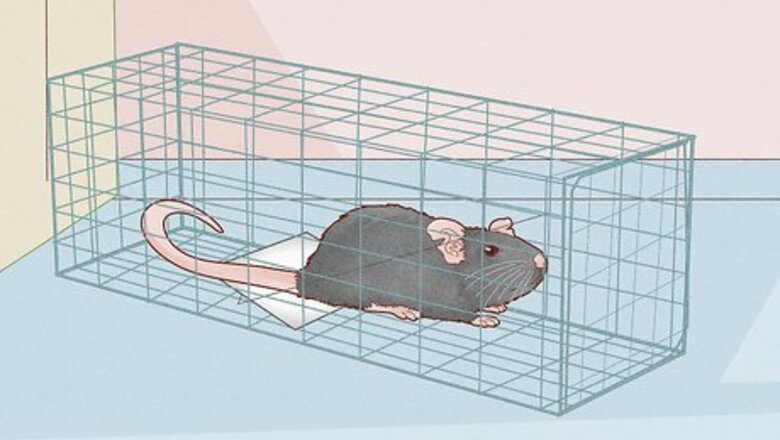
views
Look into humane traps.
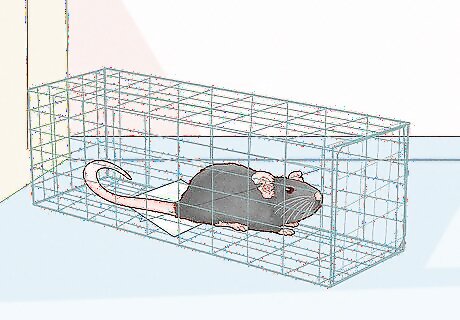
Cage traps catch the rodent alive. When the mouse or rat steps on the baited pan located inside the trap, the mechanism is tripped and the door closes. This traps the rodent without killing it. Place cage traps parallel to walls, so the rodent runs into them. Look for places with droppings and gnaw marks, or place traps in dark corners and behind furniture. For fast results, set a dozen or more traps. If no rodents are caught within three days, remove the traps for a couple days, then set them again in a new position a short distance away. When an animal is caught, handle the trap with rubber or disposable gloves and disinfect it afterward to prevent disease. If releasing outdoors, be aware that rodents can travel more than half a mile (0.8km) to return home. Indoor mice will likely not survive outdoors. Alternatively, call a veterinary clinic and ask if they will humanely kill rodents.
Consider lethal traps.
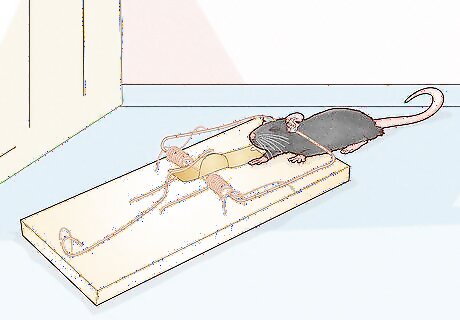
Snap traps are easy to use and kill the rodent quickly. These are the least inhumane of common traps. When the rodent attempts to take the bait, the mechanism snaps onto the neck to kill it. Traps with a larger trigger area are more effective. If you are using a classic mousetrap with only a small metal plate for the bait, attach a 2" (5cm) square of cardboard over the plate before setting the trap. Place snap traps at a right angle to the wall, with the trigger end against the wall. Dark corners and areas behind furniture work well. Glue traps are not recommended as they are inhumane options, killing mice slowly and cruelly. They are not effective against rats. To reduce risk of disease, spray disinfectant on used traps and dead animals before handling. Wear rubber or disposable gloves while disposing of the animal in a plastic bag. Wooden traps are not safe to reuse.
Experiment with bait.
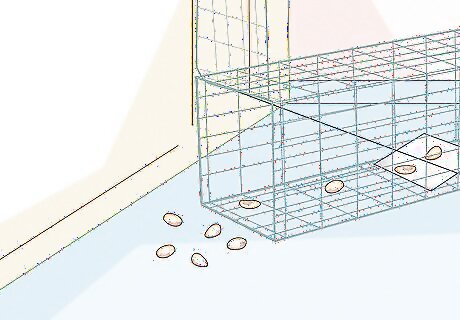
A desirable bait will make traps much more successful. Whole nuts, peanut butter, bacon, or small wads of cotton (for nesting material) are all good options that work with just about any rat or mouse species. Keep these tips in mind: Tiny pieces of bait work best. A variety of traps with different bait increases your chance of success. Fresh bait is more attractive. Replace the bait frequently.
Try poisons as a last resort.
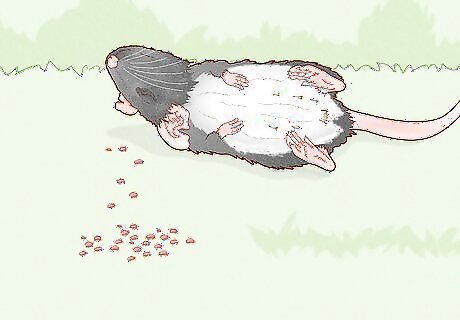
Poison is mostly useful for farms, not homes. A poisoned rodent often ends up dying within your walls or in other inconvenient locations where they are difficult to clean up. Poison is also not safe for areas with children, pets, or livestock. Consider poisons only for grain storage areas and other places that require constant protection: Some rodenticides take several days or even a couple weeks of feeding to kill the animal. Newer anticoagulants like brodifacoum or difethalone can work in a single dose and are somewhat less dangerous to humans and pets. Packets of poison can be left intact for the rodents to gnaw through. Liquid baits containing a little sugar work especially well in dry weather and for rats. Place the poison and the bait in a covered box big enough for several rodents, but not accessible to other animals or children. These work best with a hole on opposite ends, about 2½" wide (~6cm) for rats or 1½" (~3.5cm) for mice.
Make your home and yard unfriendly to rodents.
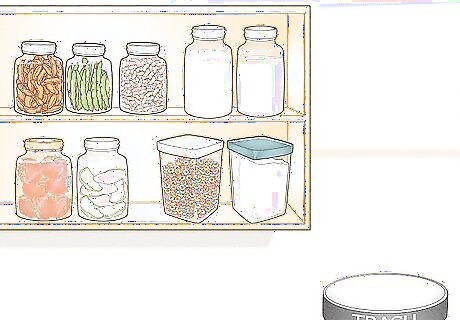
Make the area less rodent-friendly. Minimizing sources of food, water, and shelter can be extremely effective for rodent control. Clean your kitchen frequently and keep food stored in sealed containers when possible. Food storage high above the ground is less accessible to rodents. Cover all trash cans with tight-fitting lids. Clear up any piles of junk, brush, or other materials in your yard that offer shelter to rodents. Empty or cover sources of water in your yard (especially for rats, which drink more water than mice).
Try homemade repellents alongside other methods.
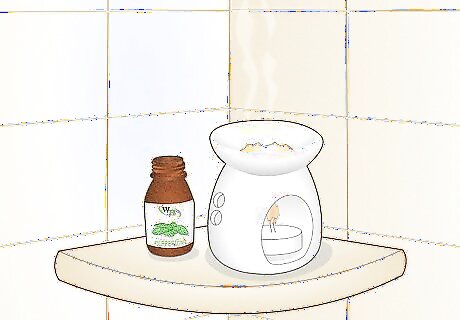
Repellent materials discourage rodents, but rarely solve the problem. There are quite a few home remedies for keeping mice and rats out of your home. Unfortunately, once a rodent is inside, it's not likely to move out into the cold or stop taking your food just because of a bad smell. But if you make cleaning and food storage your top priority, these secondary approaches might help convince your whiskered enemies to move on: Essential oils of eucalyptus, peppermint, lemongrass, basil, and thyme have all been used as rodent repellent. Try putting drops of the oil onto cotton balls and placing them strategically at openings where rodents are coming in. Steel wool is great for blocking rodent holes, as mice and rats will rarely chew through it. Try to wedge it in enough that it can't be pushed out of the way. Aluminum foil often shows up on blogs as an anti-rodent "life hack," but this is at best a mild deterrent; rats will sometimes even take the foil to insulate their nests. Covering your fruit bowl might not be a bad idea, but papering every kitchen surface in foil might annoy you more than the rats. Some people lay out scented dryer sheets hoping the fragrance will deter rodents, but there is no real evidence showing that this works. Try it if convenient, but don't bother buying any just for this purpose.
Be realistic about house pets as rodent control.
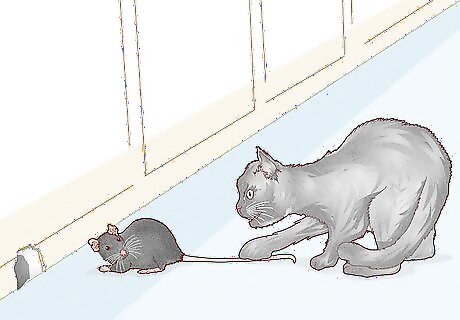
Cats (and some dogs) will deter but rarely exterminate. Housecats can help deter mice from moving in, but most of them are pretty bad at actually catching them—and rats are even more likely to get away.) Dogs (except for trained terriers and other rat-hunting breeds) usually have even less effect on an infestation, although interestingly having both cats and dogs can keep rats away better than cats alone. For best results, give your pet access to every part of the house, including storage cupboards, so the rodents have nowhere to live that doesn't smell of your pet. Keep the pet food in sealed containers and clean up the floor and pet bowls after each mealtime.
Repair cracks and holes.
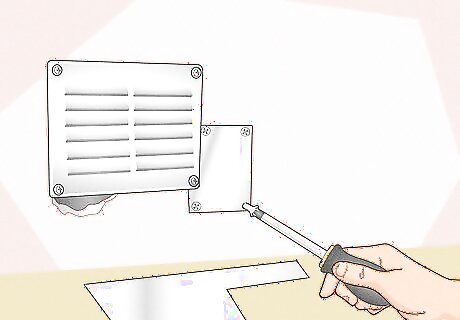
Block the openings where mice and rats enter your home. Mice and rats often wiggle their way into your living space through small cracks in your walls or roof. By filling in all of these subtle openings, you can prevent them from getting in. Block small openings with caulk, copper wool, or stainless steel wool, which the rodents can't chew through. Avoid foam caulks in places exposed to sunlight. Block gaps under doors with aluminum kick plates (≤20 US gauge). Block larger holes with galvanized sheet metal (≤24 US gauge), concrete or brick and mortar (3 ¾" / 9.5cm thick), or reinforced concrete (2" / 5cm). Block any opening ½ inch (12mm) wide if you have rats, or ¼ inch (6mm) for mice.
Rodent-proof vents and pipes.
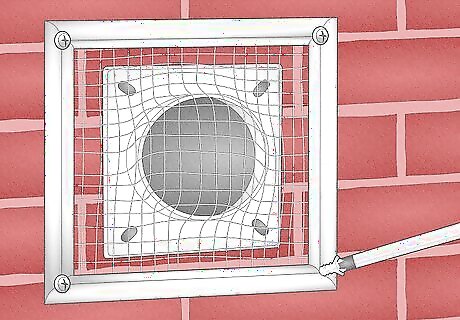
Use rodent-proof materials to block entry points. Rodents are impressive climbers and jumpers, so they may be getting into your house via drain pipes or vents. After you've dealt with your current infestation, prevent a recurrence with these materials: Rodent-proof vents and the openings of exterior drain pipes with perforated metal grills (≤14 US gauge) or hardware cloth (≤19 US gauge), with holes no larger than than ¼ inch (6mm). Dryer vents should not be covered this way, as the mesh will reduce air flow and increase fire risk. Instead, install a cover with a "floating ball check valve" that blocks the hole while the dryer is off. Seal all cracks where pipes, vents, and electrical conduits enter your walls with caulk. You can stop rodents climbing the outside of drain pipes with a 12" (30 cm) tall piece of metal flashing over the pipe, or a cone-shaped guard of the same height. This may not be worth the trouble if there are trees nearby that the rat can use to reach your roof anyway.
Contact a professional exterminator if nothing else works.
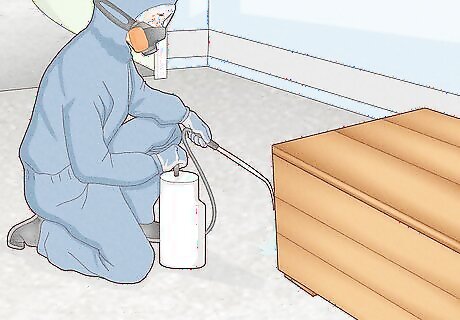
Hire an exterminator. Contact a professional rodent exterminator if you’ve tried a few different methods and you’re still having problems, or if you aren’t comfortable trapping or killing mice and rats. Ask around for recommendations, call the exterminator, and ask for a quote. Confirm that the exterminator is licensed by the state and/or a professional association.




















Comments
0 comment